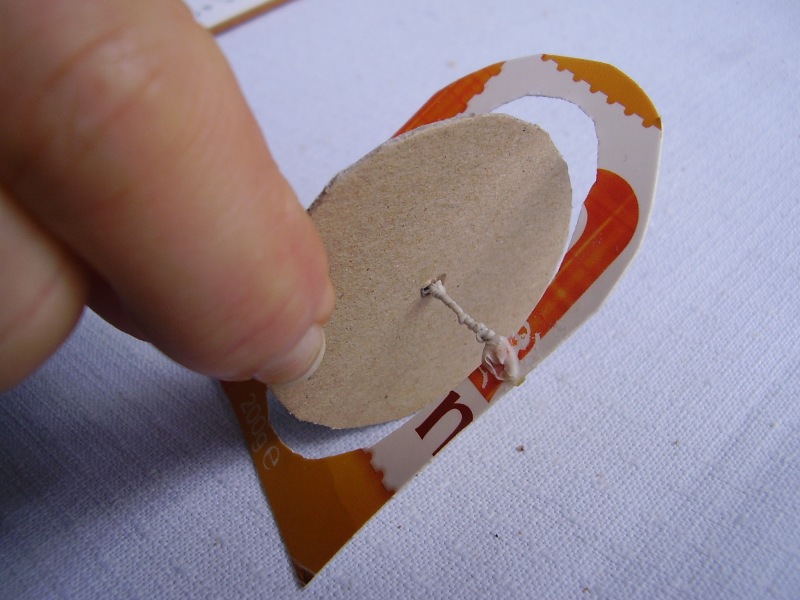rubber band cars
This is a design supplied by jeff bindon

A rubber band is stretched down the middle of a beer can through a hole in the bottom where it is retained by a paperclip

The other end is held by a hook made from a paperclip which is bent over a plastic bead to form a bearing

a straw is sellotaped to it to form a reaction arm. In order for the car to go in a straight line the reaction arm has to touch the ground near the middle of the can, so it has an angled section which can be adjusted by bending the paperclip that forms the angle.
This one is a similar sort of thing but much harder to make. It will only stand up when it's going along, because the back of the frame presses against the ground.

The 'A' frame acts as a bearing to keep the wheel aligned; I had to cut bits out of the cross-members because I made the wheel a bit too big

The wheel needs to be very carefully aligned or it won't work. It also needs to be very precisely cut, any flat bits will prevent it from turning

It will only work on a smooth floor. So its apparently simple construction conceals several quite difficult features.

This one is similar although much smaller, the rubber band is a strip 3mm wide cut from a latex glove & superglued at the ends

notice that the wheel is cut from quite heavy card, this is to maximise it's inertia & traction. In this case it weighs about 1.5 grams.

Because it folds flat it can be carried in your pocket
This one is similar, it doesn't go very fast


The cardboard 'butterfly' is weighted on the other side with about 10 grammes of blue-tack. It exerts a reaction torque which keeps the rubber band twisted. Notice the straws are pushed onto the paperclip angle brackets, this is quite a good way of attaching them and is easy to dismantle.
This one is also quite difficult to make and needs a big expanse of floor to use to its best advantage

The big propellor turns quite slowly so the rubber band takes a long time to unwind but it still goes quite fast.
The axles of the two front wheels are joined together to help it go straight; the bearing consists of two holes at the bottoms of the two supporting struts, so if the axle is a bit crooked it will still turn freely. There are short bits of narrow straw acting as spacers between the wheels and the struts, whereas the back wheel uses a bit of narrow straw as a bearing.
Movie
This is one made by Jay Breaux

It uses a blob of hot glue rubbing on some washers cut from a manilla folder as a thrust bearing.
This one goes round & round on the spot

It has a long thin rubber band made from several short ones looped together, if you have the patience you can wind it several hundred times. The drinking straws form a very long thin tripod with a plastic bead bearing at the far end, the apparent double wheel at this end is just to get the wheels both ends the same diameter I think.
Movie

explanation by jeff bindon
Mechanical energy can be stored in the stretch of a rubber band and many have used that principle to shoot it, or some other missile, across a room.
The stored energy can also be used to move a small vehicle. This is like a clockwork motor except that there the energy is stored in a steel spring. Even a thin elastic band exerts a far larger force than that needed to drive a tiny tractor and unless this force is controlled, it will shoot it off at high speed. The stretch is also very short and will hardly move a car very far. The design problem is thus to reduce the force to the few grams needed to move the tractor and also to increase the force when needed.
The short distance moved by the elastic band is increased by twisting it rather than stretching its length. This reduces the force considerably and increases the effective "stretch".
The twisting force, or torque, is applied through a thick disc of "sticky" candle wax. Stickiness (or viscosity) needs a large force to move fast but is almost frictionless when moving slowly. Thus a large proportion of the elastic force is available at low speed for climbing. A downhill runaway is prevented as the wax absorbs most of the elastic force.
watch the mars rover back out of a sand dune (4megs)
This is an attempt to regulate the power from a rubber band is with a simple
escapement that moves a balance arm.

it uses less of the rubber band's energy than the wax disc but unfortunately it's very difficult to make. The balance arm is moved by a paperclip bent to form a cam which lifts a cam follower made from another paperclip

and then drops it

every time the cam follower drops, the balance arm taps against the top of the can, making a satisfying mechanical noise. The speed can be regulated by moving the pivot point of the balance arm.

Movie
my email is davidvwilliamson@hotmail.com
back to main site


















